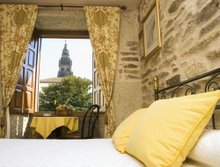 June 8
June 822 km
Quite a climb today, but Oh! what a view from the top (about 1300 meters, At O! Cebreiro). Mountain range upon mountain range, the closest bright green with accents of yellow from flowering shrubs, the farthest a distant blue.
I probably should have stopped earlier today. There were a lot of difficult ups and downs, and I did most of it in Tevas. But you get into a rhythm and you don´t want to stop. The walking is addictive. At times it feels like the pack on my pack (or something at by back), far from weighing me down, is pushing me forward. I hear from other pilgrims that they´ve experienced something similar. Some call it the wind at their back and some think it´s something more mystical.
Before I describe the day´s walk I want to sing the praises of the private hostal in Ruitelan. Run by two men who laughed and exchanged significant glances when I asked if they were brothers, this albergue is intimate and friendly. There were about 20 of us, and besides sleeping cheek to jowl we all ate dinner family-style, the best meal I´ve had on the Camino. Cream of carrot soup, green salad with fresh mozzarella, spagetti carbonara, red wine, and a delicious egg custard (natilla) for dessert.
I sat with the Italians and a young woman from South Africa. She´d just come from 3 months of studying yoga in India, and after the Camino was taking a bike tour through Portugal. She seemed at loose ends, tripping from one peak experience to the next. But she was the youngest at the table, maybe 23, so I guess she has the right.
I slept so well in my non-bunk bed that I didn´t hear the Pavoratti blasting at 6 am, and awoke to an empty bunkhouse. Not even taking time to brush the sleep from my eyes, I ran downstairs to get the last of the coffee and tostadas con miel (this area in known for its dark and flavorful honey).
Today´s route
The Camino meandered through Las Herrerias and Hospital Ingles. Bands of feral cats had colonized ruined stone houses, giving off a smell of litter box time twelve. The route pitched seriously upwards towards La Faba, on a steep, rocky path shaded with chesnut trees. La Faba was a hilltop cluster of stone houses shrouded in mist, which soon cleared to reveal great views along the now-open (no overhanging trees) trail.
In Laguna de Castilla I saw my first castro, a round stone hut with thatched roof. We´re in Galicia now, with its Celtic culture, and the castros look like something you´d see in Ireland, as do the emerald green sloping fields bounded by stone walls. The place smelled like woodsmoke, fresh cow dung, and damp earth.
It started to drizzle, and pilgrims stopped under trees to break out the ponchos and pack covers. But the rain stopped almost as soon as it started, and I was fine with my long´sleeved white nylon button-down shirt, which dries fast and is also good protection against the sun.
This area is pretty poor, and most young people go to some nearby city to look for work. The villages are populated with middle aged and older people. If you come across a teenager or young adult they seem peeved to have been left behind with the fogies. And there are more women than men--you see women working the small vegetable plots, herding the sheep and cows (with the help of German Shepards), or tending the only bar in town. I heard some German pilgrims talking about how when Spain joined the EU (now the EC), they got a lot of money to bring their infrastucture up to the level of the other countries in the Community. So what you have around here are excellent roads but nobody to drive them.
O Cebreiro was a different story. A hilltop hamlet of 20 ancient stone houses, it has become very touristy, with shops selling pilgrim paraphernalia (hats, t-shirts, staffs, and the ubiquitious scallop shell painted with Santiago´s red cross) and Celtic gewgaws. Odd to see jewelry and the like sporting colorful Celtic knots like the ones in the Book of Kells and all over Ireland. One tourist shop piped bagpipe music out into the cobblestoned street. A tourist in high heels and silk shawl was wearing a pilgrim´s scallop shell around her neck, oblivious to the outraged stares of real pilgrims.
Liñares was a roadside anomoly--instead of being clustered aorund the usual stone church, the town had at its center a garage specializing in the repair of farm equipment. Bright green and red farm machinery, looking like modern torture implements, littered the fields. A few young bucks (probably mechanics at the garage) tore up the camino on All Terrain Vehicles, leaving clouds of dust for the pilgrims ot breathe.
In Fonfria I´m at the Albergue da Reboleira. Arrived around 3 pm to snag one of the last bunks. Splurged on a massage by a Catalan woman who also tends bar at the albergue. Pilgrim special: 15 euros for 35 minutes. The massage table was a door draped in an old blanket in a room so close to the bar I could hear clinking glasses and the French Open on tv. But it felt great, especially when she rubbed lavender-scented oil into my feet.
Now it´s pouring down rain, with thunder and lightening. So glad I´m not out on the trail.





2 comments:
I once saw Daisy cook Caldo Gallego on tv, but I missed the smell of damp earth
Beautiful post.
Are you sticking to your budget? Have you purchased any trinkets? I'm a sucker for that stuff!
Via con dios, Erin.
Post a Comment